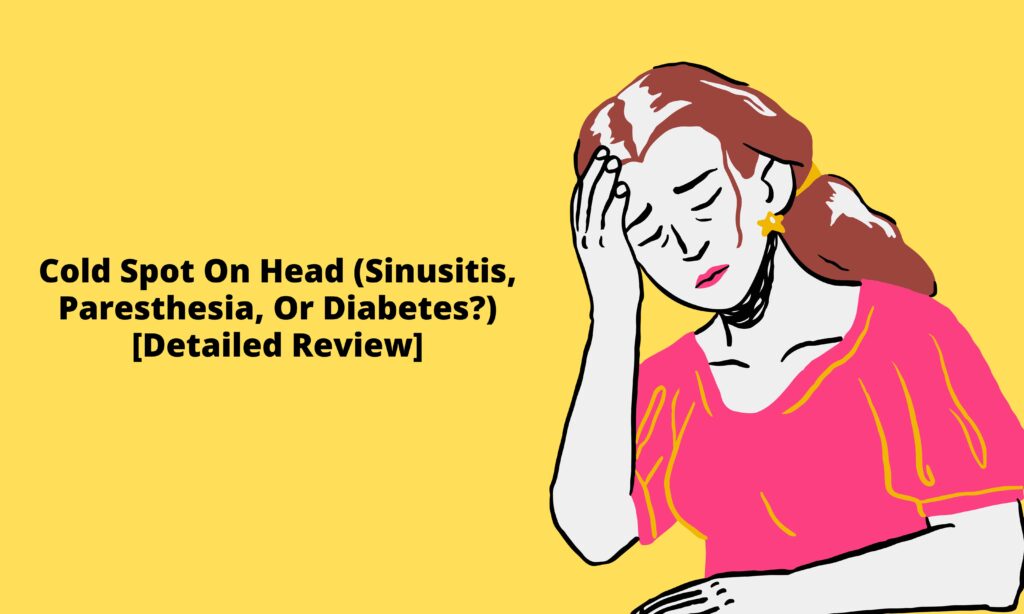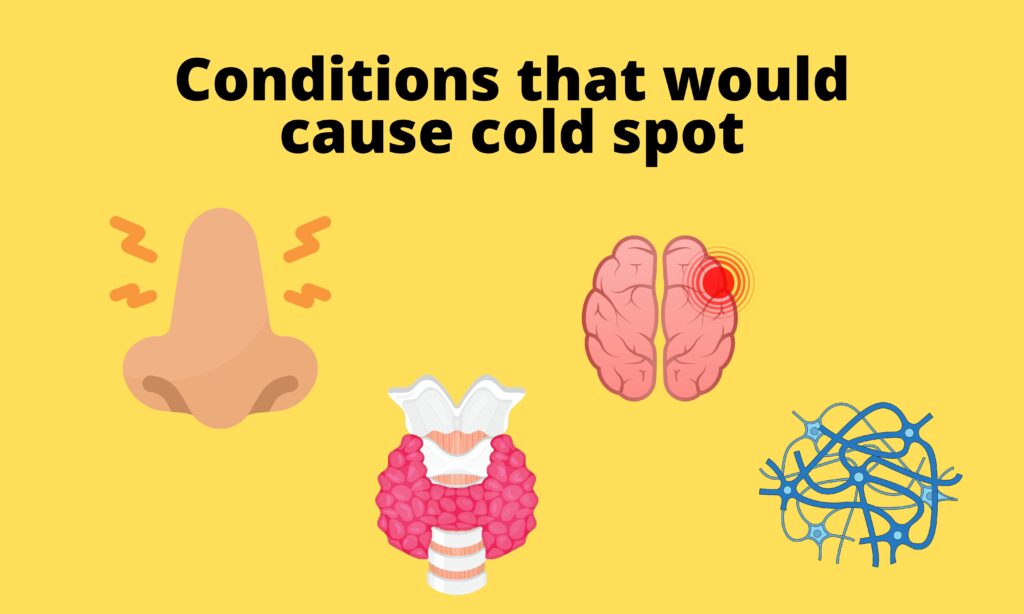
If you’ve noticed that the top of your head feels cold, it could be a sign of a variety of underlying health issues. While it’s easy to dismiss a cold spot on your head as a minor annoyance, it’s important to pay attention to your body’s signals and seek medical attention if necessary.
Sinusitis: The Common Culprit
One of the most common causes of a cold spot on the top of the head is sinusitis. This condition occurs when the sinuses become inflamed or infected, leading to a buildup of pressure in the head. This pressure can cause a sensation of coldness, as well as other symptoms such as facial pain, congestion, and headaches. If you suspect that your cold spot is caused by sinusitis, it’s important to seek treatment from your healthcare provider.
Paresthesia: Nerve Damage
Another potential cause of a cold spot on the head is paresthesia. This condition occurs when there is damage to the nerves that supply sensation to the scalp. This damage can be caused by a variety of factors, including injury, infection, or disease. Symptoms of paresthesia can include a feeling of coldness or numbness in the affected area, as well as tingling or a pins-and-needles sensation. If you suspect that your cold spot is caused by paresthesia, it’s important to seek evaluation from a healthcare professional to determine the underlying cause and develop an appropriate treatment plan.
Diabetes: The Silent Culprit
In some cases, a cold spot on the top of the head can be a sign of diabetes. Diabetes is a chronic condition that affects how the body processes glucose (sugar), and can lead to a range of complications if left untreated. One of the early signs of diabetes is nerve damage, which can cause a sensation of coldness or numbness in the affected area. Other symptoms of diabetes can include increased thirst, frequent urination, and fatigue. If you suspect that your cold spot may be related to diabetes, it’s important to seek evaluation from a healthcare provider.
When to Seek Medical Attention
If you’re experiencing a cold spot on the top of your head, it’s important to pay attention to any other symptoms that may be present. If you have additional symptoms such as headache, facial pain, or numbness, it’s important to seek medical attention. Similarly, if you have a history of diabetes or other medical conditions that may be contributing to your symptoms, it’s important to discuss your concerns with a healthcare professional. Prompt evaluation and treatment can help to identify and address underlying health issues and prevent complications.
In conclusion, a cold spot on the top of your head can be a sign of a variety of underlying health issues, including sinusitis, paresthesia, or diabetes. If you’re experiencing this symptom, it’s important to pay attention to any other symptoms that may be present and seek evaluation from a healthcare professional if necessary. With prompt diagnosis and treatment, many underlying health issues can be effectively managed and treated, allowing you to feel your best and enjoy optimal health.
Conditions that would cause cold spot

If you’re experiencing a sensation that the top of your head feels cold, it could be a sign of an underlying health condition. In some cases, a cold spot on the head may be harmless and not require medical attention. However, there are certain conditions that could cause a cold spot on the head, and it’s important to be aware of these conditions so that you can seek treatment if necessary.
Sinusitis: Inflammation of the Sinuses
One of the most common causes of a cold spot on the head is sinusitis. Sinusitis is a condition in which the sinuses become inflamed or infected. When this happens, the pressure in the sinuses can cause a sensation of coldness on the top of the head. Other symptoms of sinusitis may include facial pain, headache, nasal congestion, and fever. If you suspect that your cold spot is caused by sinusitis, it’s important to seek treatment from your healthcare provider.
Paresthesia: Nerve Damage
Another possible cause of a cold spot on the head is paresthesia, which is a condition that involves damage to the nerves that supply sensation to the scalp. This can occur due to injury, infection, or disease. Symptoms of paresthesia may include a sensation of coldness, numbness, tingling, or pins-and-needles on the top of the head. If you suspect that your cold spot is caused by paresthesia, it’s important to seek evaluation from a healthcare professional to determine the underlying cause and develop an appropriate treatment plan.
Migraine: A Type of Headache
Migraine is a type of headache that can cause a variety of symptoms, including a cold spot on the head. Migraine headaches may be accompanied by nausea, vomiting, sensitivity to light and sound, and visual disturbances. The cold spot on the head may be due to the dilation and constriction of blood vessels that occurs during a migraine attack. If you suspect that your cold spot is related to migraine, it’s important to seek evaluation from a healthcare professional to determine the underlying cause and develop an appropriate treatment plan.
Hypothyroidism: Low Thyroid Function
Hypothyroidism is a condition in which the thyroid gland does not produce enough thyroid hormone. This can cause a variety of symptoms, including fatigue, weight gain, cold intolerance, and a sensation that the top of the head feels cold. If you suspect that your cold spot is related to hypothyroidism, it’s important to seek evaluation from a healthcare professional to determine the underlying cause and develop an appropriate treatment plan.
When to Seek Medical Attention
If you’re experiencing a cold spot on the top of your head, it’s important to pay attention to any other symptoms that may be present. If you have additional symptoms such as headache, facial pain, or numbness, it’s important to seek medical attention. Similarly, if you have a history of medical conditions that may be contributing to your symptoms, it’s important to discuss your concerns with a healthcare professional. Prompt evaluation and treatment can help to identify and address underlying health issues and prevent complications.
In conclusion, a cold spot on the top of the head can be a sign of an underlying health condition, including sinusitis, paresthesia, migraine, or hypothyroidism. If you’re experiencing this symptom, it’s important to pay attention to any other symptoms that may be present and seek evaluation from a healthcare professional if necessary. With prompt diagnosis and treatment, many underlying health issues can be effectively managed and treated, allowing you to feel your best and enjoy optimal health.
FAQs

FAQs about Top of Head Feels Cold
If you’re experiencing a sensation that the top of your head feels cold, you may have questions about what could be causing this symptom and what you can do to alleviate it. Here are some frequently asked questions about this topic.
What could be causing my top of head to feel cold?
There are several potential causes of a cold spot on the top of the head, including sinusitis, paresthesia, migraine, and hypothyroidism. These conditions can cause a variety of other symptoms as well, so it’s important to seek evaluation from a healthcare professional if you’re experiencing this symptom.
What are some other symptoms that may accompany a cold spot on the top of the head?
Depending on the underlying cause, a cold spot on the top of the head may be accompanied by symptoms such as headache, facial pain, numbness, tingling, nausea, vomiting, sensitivity to light and sound, visual disturbances, fatigue, and weight gain.
Is a cold spot on the top of the head a serious symptom?
In some cases, a cold spot on the top of the head may be harmless and not require medical attention. However, if you’re experiencing other symptoms or have a history of medical conditions that could be contributing to your symptoms, it’s important to seek evaluation from a healthcare professional to rule out any serious underlying health issues.
What can I do to alleviate a cold spot on the top of my head?
The treatment for a cold spot on the top of the head will depend on the underlying cause. If the symptom is due to sinusitis, for example, treatment may involve antibiotics or other medications to reduce inflammation. If the symptom is due to paresthesia, treatment may involve physical therapy, medications, or other interventions to address nerve damage. It’s important to work with a healthcare professional to develop an appropriate treatment plan.
When should I seek medical attention for a cold spot on the top of my head?
If you’re experiencing a cold spot on the top of your head along with other symptoms such as headache, facial pain, or numbness, it’s important to seek medical attention. Similarly, if you have a history of medical conditions that may be contributing to your symptoms, it’s important to discuss your concerns with a healthcare professional. Prompt evaluation and treatment can help to identify and address underlying health issues and prevent complications.
In conclusion, a sensation that the top of your head feels cold can be a sign of an underlying health condition. If you’re experiencing this symptom, it’s important to seek evaluation from a healthcare professional to determine the underlying cause and develop an appropriate treatment plan. With prompt diagnosis and treatment, many underlying health issues can be effectively managed and treated, allowing you to feel your best and enjoy optimal health.
Conclusion
In conclusion, experiencing a sensation that the top of your head feels cold can be a symptom of several underlying health conditions. It’s important to seek evaluation from a healthcare professional if you’re experiencing this symptom, particularly if it’s accompanied by other symptoms such as headache, facial pain, or numbness.
The main causes of a cold spot on the top of the head include sinusitis, paresthesia, migraine, and hypothyroidism. These conditions can cause a variety of other symptoms as well, so it’s important to discuss your concerns with a healthcare professional to determine the underlying cause and develop an appropriate treatment plan.
Treatment for a cold spot on the top of the head will depend on the underlying cause. If the symptom is due to sinusitis, for example, treatment may involve antibiotics or other medications to reduce inflammation. If the symptom is due to paresthesia, treatment may involve physical therapy, medications, or other interventions to address nerve damage.
It’s important to seek medical attention promptly if you’re experiencing a cold spot on the top of your head along with other symptoms such as headache, facial pain, or numbness. Similarly, if you have a history of medical conditions that may be contributing to your symptoms, it’s important to discuss your concerns with a healthcare professional.
In some cases, a cold spot on the top of the head may be harmless and not require medical attention. However, if you’re experiencing other symptoms or have a history of medical conditions that could be contributing to your symptoms, it’s important to seek evaluation from a healthcare professional to rule out any serious underlying health issues.
In summary, if you’re experiencing a sensation that the top of your head feels cold, it’s important to take note of any accompanying symptoms and seek medical attention if necessary. With prompt evaluation and treatment, many underlying health issues can be effectively managed and treated, allowing you to feel your best and enjoy optimal health.